All About Polyps
1/25
There's no tags or description
Looks like no tags are added yet.
Name | Mastery | Learn | Test | Matching | Spaced |
|---|
No study sessions yet.
26 Terms
What are the Four Types of Gastric Polyps
Fundic Gland Polyps
Gastric Hyperplastic Polyps
Adenomatous Polyps
Hamartomatous Polyps
What are Fundic Gland Polyps

Fundic Gland Polyps are the most common gastric polyp found in Western countries
→ one or multiple small polyps and are located in the gastric body
→ found more in middle women and are seen in patients that have been on long-term PPI use
→ essentially non-malignant, but can be seen in FAP patients where you would want to remove them to prevent low grade dysplasia or adenoma development
What is a Gastric Hyperplastic Polyp
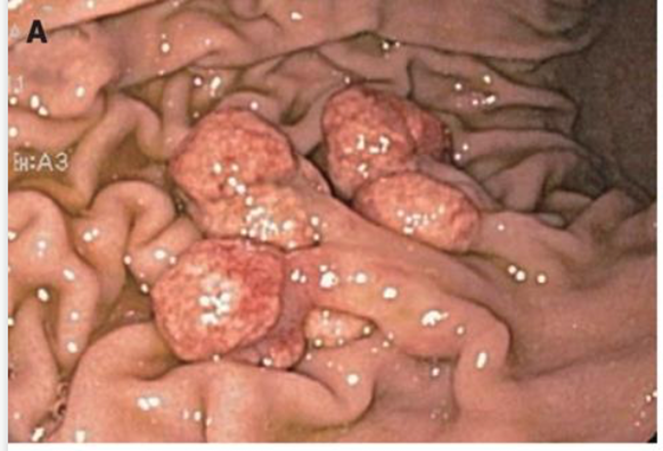
Most common gastric polyp seen in patients with H. pylori infection
→ often occur in groups and have a low malignant potential and can occur anywhere in the stomach
→ on endoscopy in the stomach you might see clusters of red inflammed polyps
What is a Gastric Adenomatous Polyp?

Most common neoplastic polyp or cancer forming polyp of the stomach
→ increased occurrence in patients with chronic inflammation and are typically solitary polyps
→ has an increased risk of dysplasia and invasive carcinoma especially if it is larger in size, flat, and has exhibited some degree of dysplasia
These polyps are always removed and are associated with FAP
What are the four categories of gastric adenomatous polyps?
Four Categories
Located in the Antrum
1) Intestinal
2) Foveolar
Located in the Cardia
3) Pyloric Gland
4) Oxyntic - Parietal Cells
What are Gastric Hamartomatous Polyp?
Gastric Hamartomatous Polyps are typically solitary and typically occur in the small intestine: jejunum > ileum > duodenum
→ sporadic tumors that are presented as benign
1) if these tumors occur as a group they are associated with a syndrome
→ Peutz-Jeghers Syndrome
→ Juvenile polyposis syndrome
→ PTEN harmatoma syndrome (Cowden Syndrome)
→ Cronkhite Canada
If these occur in a group they are often malignant
What are small bowel polyps?

Small bowel polyps are extremely rare with the most common being an adenoma
1) when it does appear it typically appears in the distal duodenum (D3,D4) as well as the ampulla and periampullary area (area where the pancreas drains into the small intestine)
→ when found in the small bowel the adenomas are typically tubulovillous and villous
2) often associated with syndromes but when they are sporadic you need to do a colonoscopy as the patient has a higher risk for concomitant colonic polyps
What do patients with hamartomatous polyps present like?
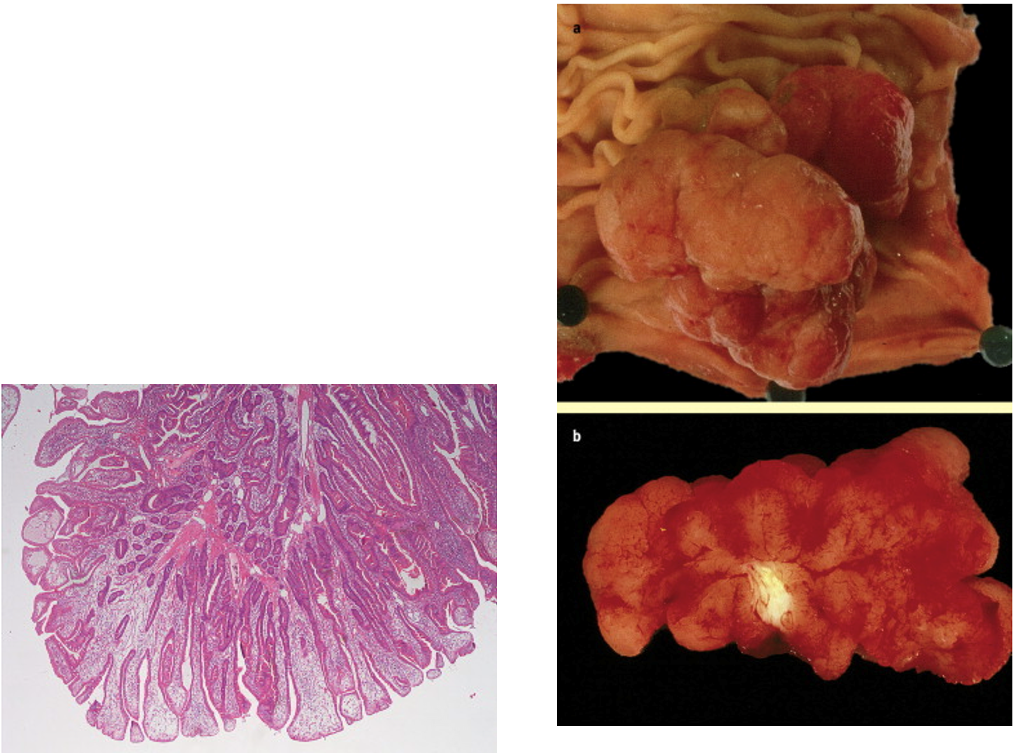
Patients with hamartomatous polyps will typically have some adjacent syndrome such as Peutz-Jeghers, Cowden, Cronkhite Canada and Juvenile Polyposis Syndrome
→ seen most commonly in the jejunum > ileum > duodenum
Patients have this present early on in life
→ cause bleeding and anemia
→ sometimes can cause obstruction, pain and intussusception
What are the seven types of colon Polyps?
Colon Polyps are subdivided based on malignant potential and do not have malignant potential
Malignant
→ tubular adenoma
→ tubulovillous adenoma
→ villous adenoma
→ sessile serrated lesion/polyp
Often Benign
→ hyperplastic polyp
→ inflammatory polyp
→ hamartomatous polyp
What is the polyp to cancer sequence?
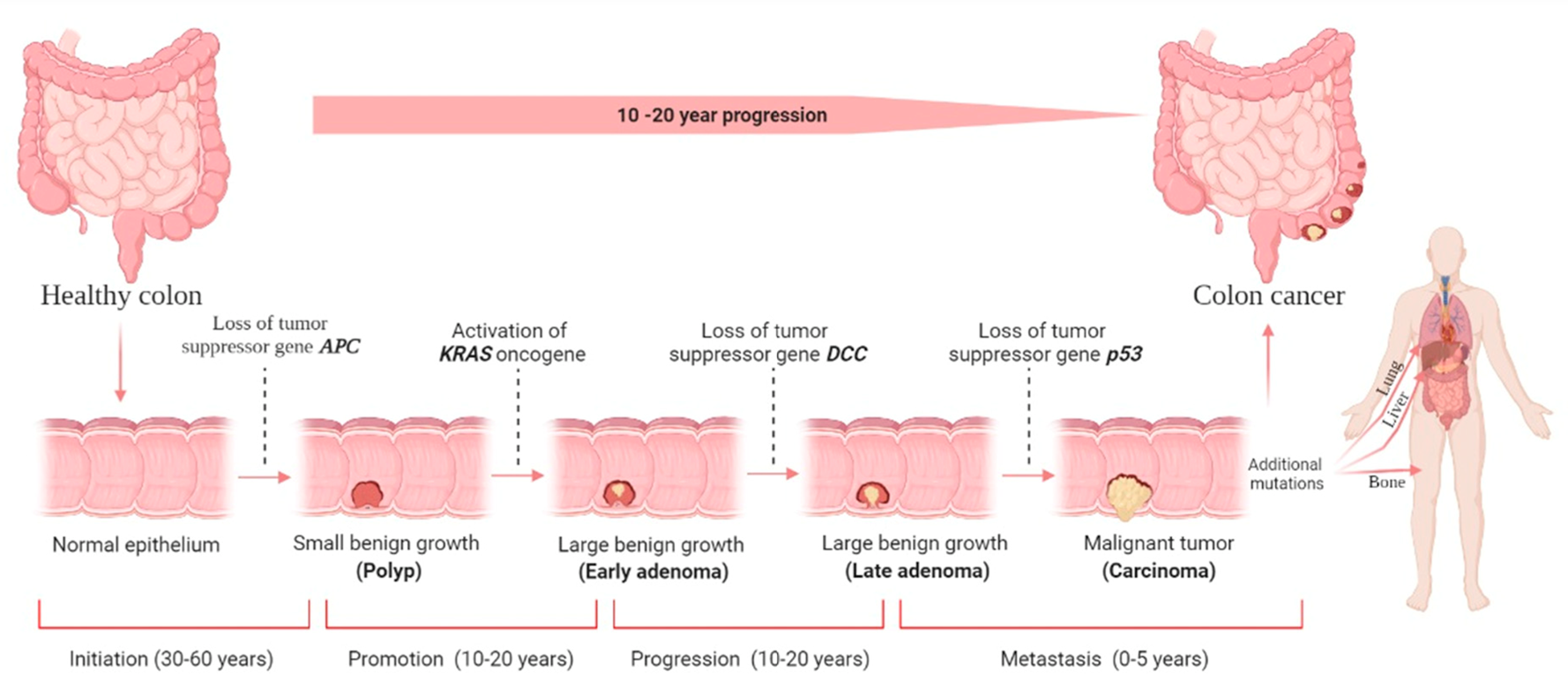
development to polyp to cancers follows a switching of loss of tumor suppressor genes and oncogene gain of function
1) Loss of tumor suppressor genes (APC)
→ loss of the APC suppressor gene leads to polyp formation (small benign growth)
2) Oncogene gain function (KRAS)
→ activation of KRAS oncogene will cause the polyp to become an early adenoma
3) Loss of tumor suppressor gene (DCC)
→ allows for the early adenoma to grow and become a late adenoma
4) Loss of tumor suppressor gene (p53)
→ loss of p53 allows for metastasis to occur and become a malignant carcinoma
What are Tubular Adenomas

The most common type of colonic polyp
1) the most important risk factor is increasing age and is seen more commonly in men than women
→ seen in the left colon and rectum more often
2) Below 10 cm they are asymptomatic while above that measurement they become symptomatic
→ can cause bleeding leading to iron deficient anemia and obstruction
→ most of them have low grade dysplasia
3) looks like the gyri of the brain on endoscopy
What are Tubular Adenomas with Villous Features?
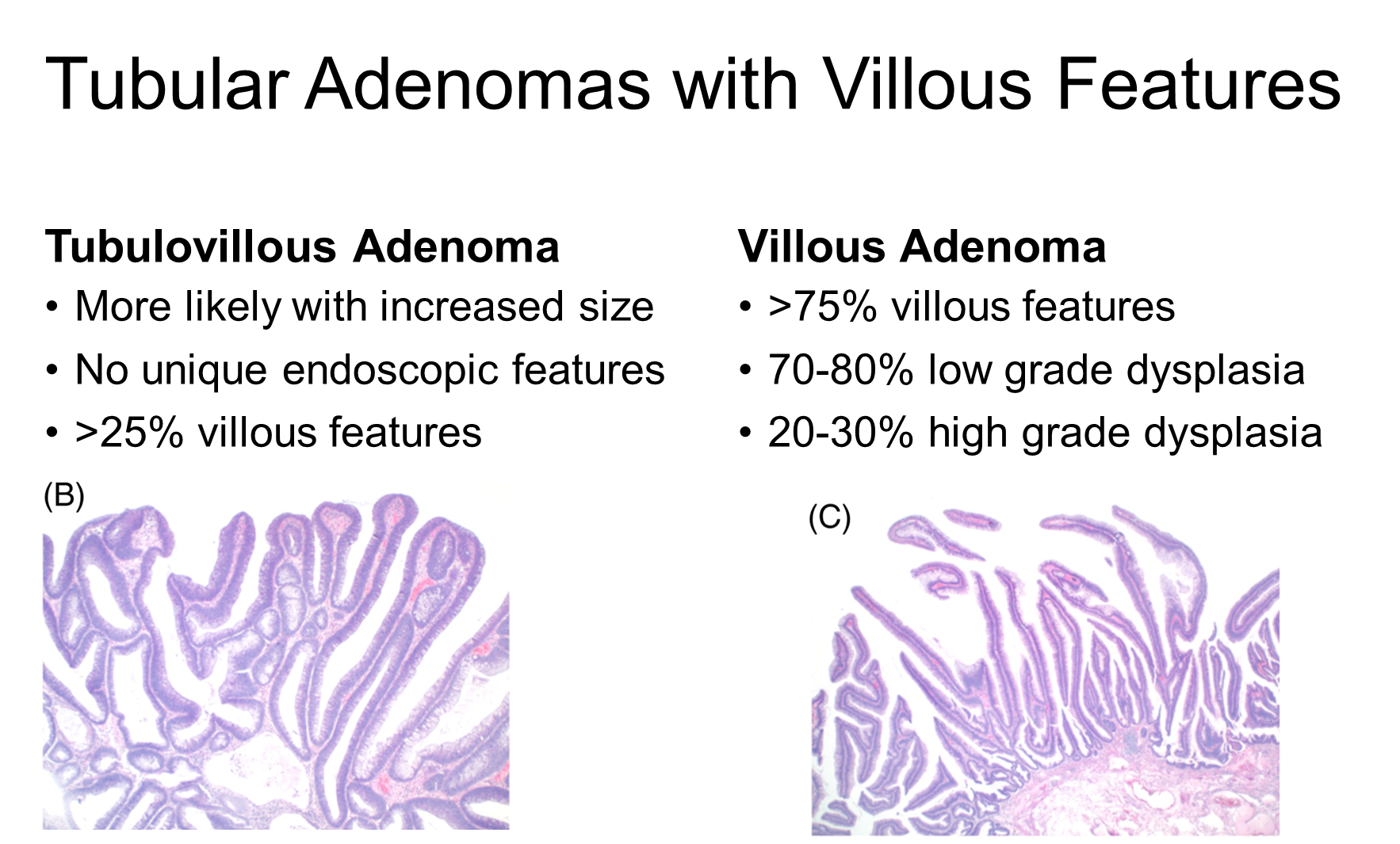
Adenomas follow a stage of progression, going from tubular, to tubulovillous, to villous
→ Villous Adenomas have a higher likelihood of developing into cancer than Tubulovillous Adenomas
1) Tubulovillous Adenomas have shared features of both tubular and villous adenomas
→ can progress into a villous adenoma
What is Lynch Syndrome
Lynch Syndrome or Hereditary Non-Polyposis Colon Cancer Syndrome
1) caused by a germline mutation in DNA mismatch repair (MMR genes) and can cause cancers that have high microsatellite instability (mutations in small DNA segments) and are associated with cancers outside of the colon
→ patients will often have a long family history of cancer and then will come to the office with rectal bleeding
2) 3-2-1 Amsterdam Criteria can be useful in determining the presence of Lynch Syndrome
→ 3 relatives with cancer
→ 2 generations affected
→ 1 cancer appearing before age of 50
What is Familial Adenomatous Polyposis Syndrome
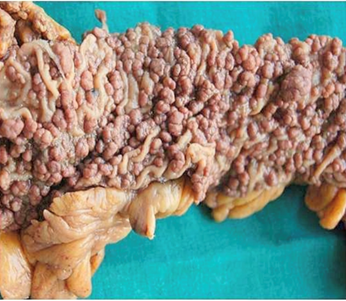
1) FAP is a syndrome that typically presents in the 20s-30s
→ caused by a germline mutation in the APC gene but the syndrome has variable penetration meaning that disease does not always present
2) patients will have more than 100s of polyps with the colonic mucosa being covered in polyps
→ patients can have extracolonic cancers and are associated with benign thyroid nodules
What is Turcot Syndrome

Turcot Syndrome is a condition where Lynch Syndrome or FAP is present with the addition of brain cancer
1) Type 1 - Lynch + brain tumor
→ mismatch repair defect
→ Glioblastomas
→ Cafe au lait spots
2) Type 2 - FAP + brain tumor
→ APC gene
→ Medulloblastomas (cerebellum)
What is Gardner Syndrome

Autosomal dominant condition characterized by the presence of FAP and colonic and extra colonic tumors
patients will have the germline mutation of APC but have additional tumors such as
1) Desmoid tumors - tumors that grow out of the connective tissues of the body
→ includes lipomas and osteomas or bone growths
2) Congenital hypertrophy of retinal pigment epithelium (CHRPE)
→ flat pigmented spot in the retina
What is MUTYH-associated polyposis
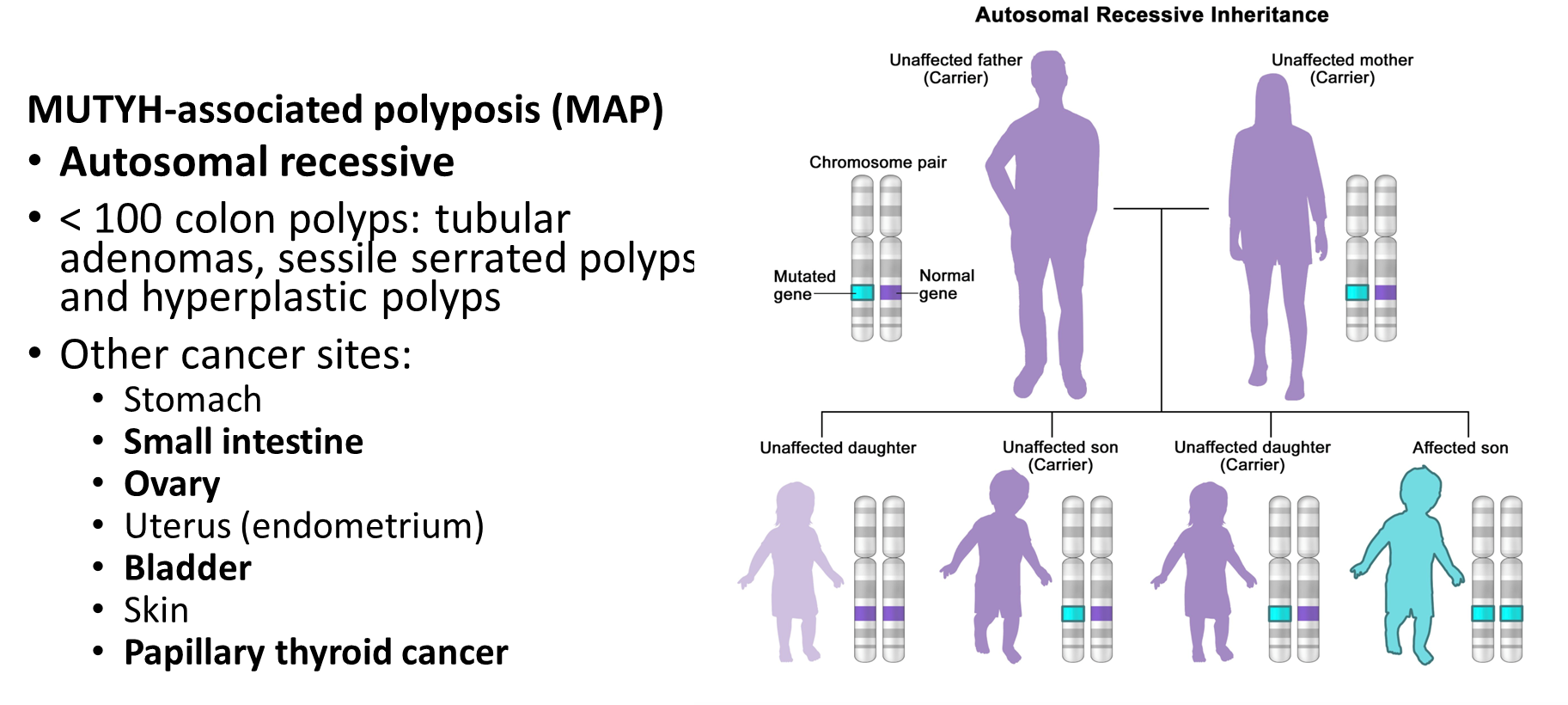
Autosomal recessive condition that causes excessive colon polyp growth (less than 100)
→ the polyps developed will usually be tubular adenomas, sessile serrated polyps or hyperplastic polyps
Cancer will commonly manifest in other sites as well
→ small intestine
→ ovary
→ bladder
→ papillary thyroid cancer
What are Sessile Serrated Polyps
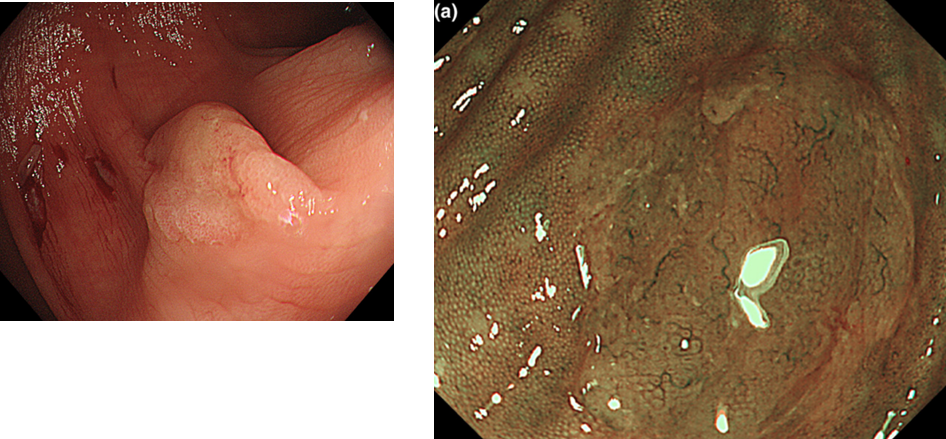
Colonic Polyps that appear commonly in the right colon
→ more common in women and smokers with malignant potential
→ polyps are very flat and are difficult to see with telangiectasia (spiderweb like patterns caused by blood vessels)
What are Hyperplastic Polyps of the Colon
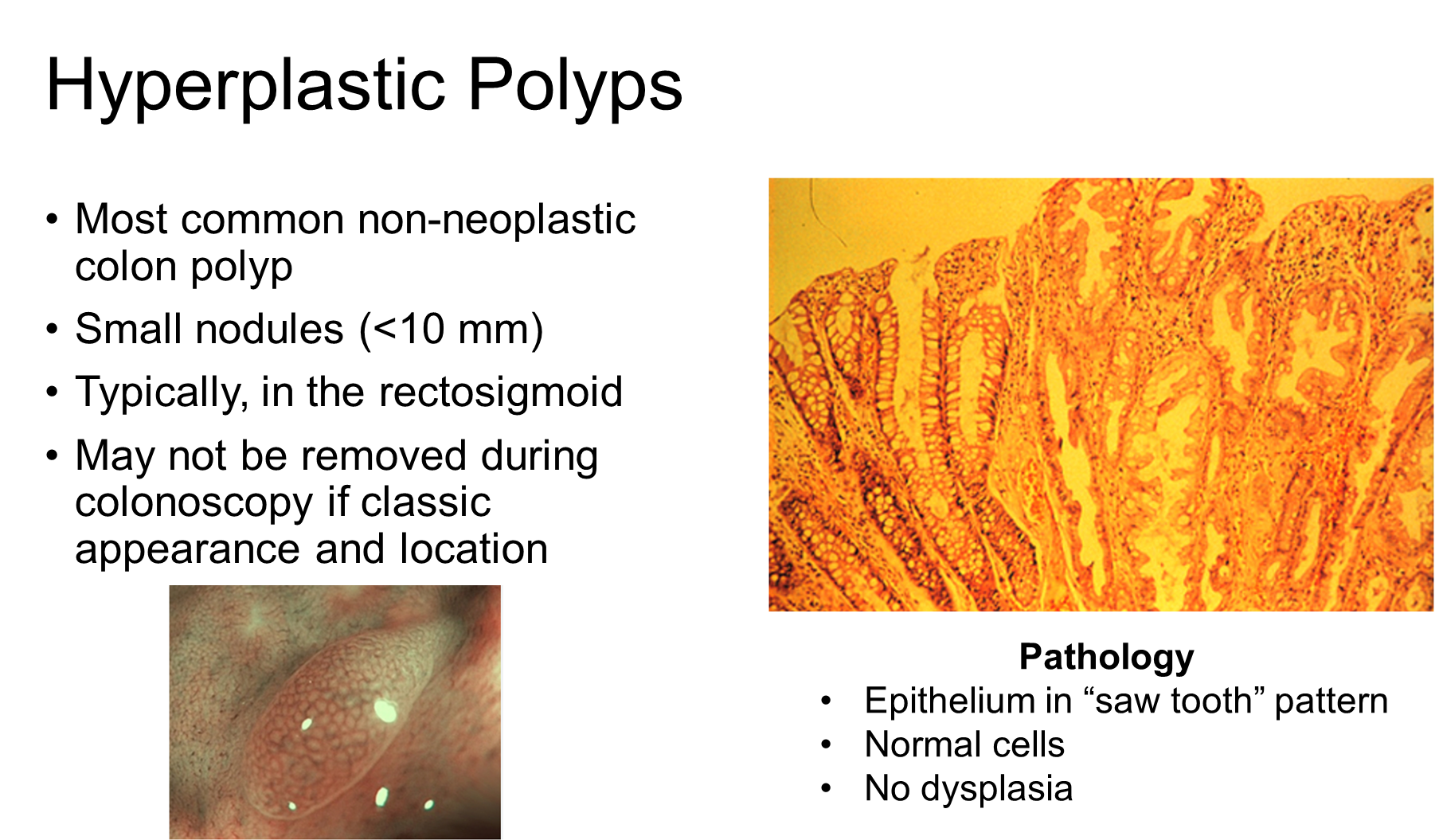
The most common non-neoplastic colon polyp
→ usually small in size and are located in the rectosigmoid area - does not require resection
How do Hamartomatous Polyps appear in the colon? What can these look like?
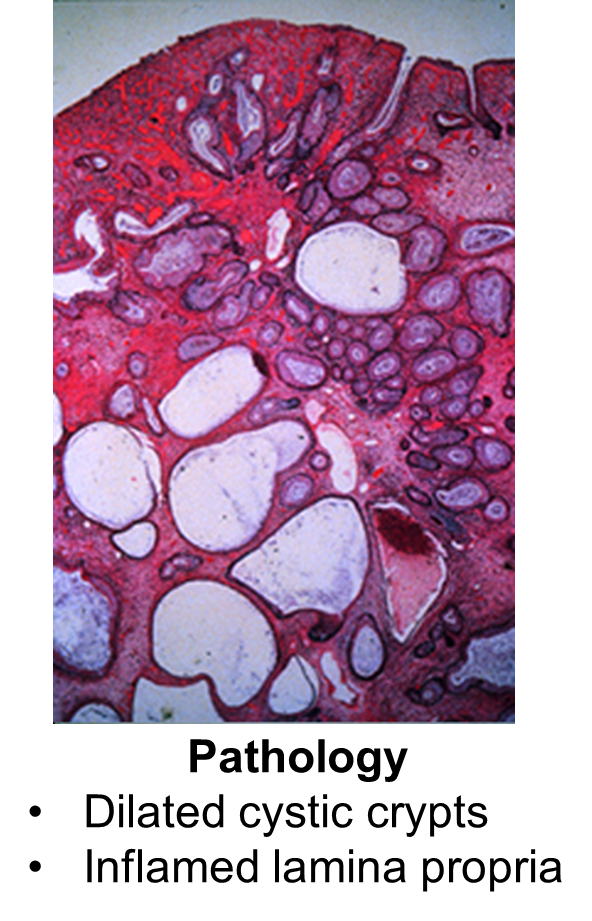
Hamartomatous Polyps in the colon will typically appear in children more than adults in the left colon or rectum
→ patients will present with hematochezia or bright red blood in the stool due to ulceration of the surface
→ can also have abdominal pain and prolapse
Polyps will have dilated cystic crypts and an inflammed lamina propria on inspection
What is Juvenile Polyposis Syndrome
Autosomal Dominant Syndrome that can cause the development of Hamartomatous polyps throughout the GI tract
→ causes an increased risk of colon cancer
→ often associated with SMAD4 mutations which can also increase the risk of gastric cancer in these patients
What is Peutz-Jeghers Syndrome?

Syndrome that causes increased number of Hamartomatous polyps due to a mutation in STK11
→ while the hamartomatous polyps in Peutz-Jegher Syndrome are benign patients will have increased risks of GI cancers and non GI cancers and can often have telangiectasis of the lips
What is Cronkhite Canada Syndrome
Extremely rare immune mediated syndrome that increases the incidence of hamartomatous polyps
→ patients will often have some sort of skin manifestation like alopecia or hyperpigmentation
→ compared to the other syndromes, this would be sporadic and appear later in life
What is Cowden Syndrome
An autosomal dominant syndrome that increases the incidence of hamartomas in the colon
→ associated with a mutation in PTEN, a gene that is a negative regulator of the mTOR pathways which is involved in the cell-cycle
→ causes breast cancer and thyroid lesions
→ associated with glycogenic acanthosis esophagus which are small raised plaques of the esophagus
What is an Inflammatory Polyp

Polyp that lacks neoplastic potential and is divided into two major groups:
1) Inflammatory Pseudopolyp
→ areas of colonic mucosa that were ulcered before and then healed
→ characteristic of Ulcerative Colitis and are often seen in groups and are pedunculated
2) Prolapse type Inflammatory Polyp
→ Damage to the mucosa from peristalsis (twisting or traction)
→ often inflamed or ulcerated acting like a ball in valve obstruction
→ occurs most often at the rectoanal verge, diverticula, and rectosigmoid junction
What does follow up colonoscopy depend on?
•Polyp type(s)
•Polyp size
•Number of polyps
•Absence vs presence of dysplasia